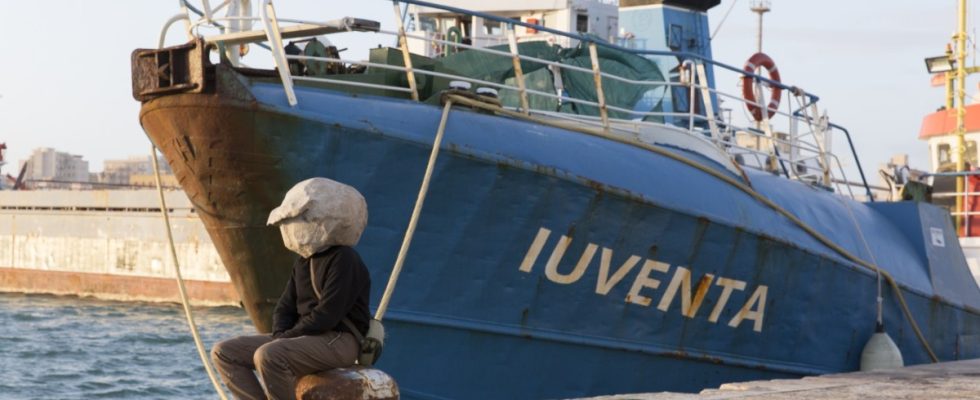The whistle, bright red and huge, hovers over an embroidered fabric banner that is iridescent in earth tones. Sections of furry, feathery animals put together to form a patchwork. “The foxes of the forced deportation always come at night to take a chicken,” it says at one point. The whistle, in modern societies the demonstrators use it to warn each other. But it is also a symbol of power. Until a few decades ago, didn’t we tend to think of the policeman who directs traffic? And then there’s the leopard. Not the one on quiet feet, but the one on crunching, rattling chains. Martial war images push themselves in front of the natural idyll.
And you’re right in the middle of the exhibition “Now that I can hear you, my eyes hurt (tumult)” by Natascha Sadr Haghighian in Munich’s Lenbachhaus. One has just passed the eponymous work on the mezzanine, has had a brief look at the tableau in the foyer, laid out with Lego panels in blue, green, blue, which bears the cryptic title “Pssst Leopard 2A7+” and into which one – in the literal – can listen into it. Which brings up two important building blocks of the artist: words and sounds and how they can lead people to new ways of seeing. Later, in the main room of the exhibition that has just opened, you will encounter even more sounds – and an installation made of large tongues that stand for a choir that speaks in many languages.
Natascha Sadr Haghighian with Zeynab Izadya: the fabric banner “Now that I can hear you, my eyes hurt (tumult)” in the Lenbachhaus.
(Photo: Courtesy the artists)
In the German Pavilion at the Venice Biennale 2019, the fictional character Natascha Süder Happelmann met the then Foreign Minister Heiko Maas.
(Photo: Xander Heinl)
The Iranian-German installation and video artist, born in Tehran in 1967, became known to a broader public in 2019 when she worked in the German pavilion at the Venice Biennale. The works in the pavilion initially caused less of a sensation than their appearance. As Natascha Süder Happelmann, she – with her head hidden under a papier-mâché stone – gave Sibylline answers to questions about where she came from and where she went (among other things in the form of drawings by the Süddeutsche Zeitung) and met the Foreign Minister at the time, Heiko Maas, in exactly the same outfit and stoic attitude – the stone is old and patient.
A number of the Biennale works can now also be seen in the Lenbachhaus. And at the latest with the Leopard work in the foyer, a “sound investigation” that she has been working on since 2013, one becomes aware of how up-to-date her artistic field research is. How different people looked at the Leopard main battle tank before the Russian war of aggression in Ukraine. Peace songs and anti-war speeches, political decisions and snippets of conversations about the Ukraine war and from other crisis areas as well as from the armament environment, but also historical, musical and literary quotations come together here, but only become accessible when you get to grips with the two-pole chinch plugs in – another hidden reference to the multi-channel thinking in the works.
The 48-channel sound installation “tribute to whistle” consists of six compositions of different lengths that she commissioned, which fill the room with sound in different arrangements. Whether as a whistle, as a bird’s chirping, as an electronically alienated set piece – the random composition plays with the aggressive as well as the peaceful meaning of trilling and whistling and has multi-layered connotations. If you don’t want to explore this background, you can simply step into this sound garden and let yourself be carried away by the emotional level – that works too.
Natascha Sadr Haghighian: Digital drawing from the Tumult + Accumulation series.
(Photo: Courtesy the artists)
The works of Natascha Sadr Haghighian also and above all live from the socio-political discourse. Migration, migrant work, refugee aid, exploitation of people and nature – as a “stone person” she wandered through Bavaria and Italy on the trail of people who had fled. There are videos, photos, installations and drawings. In her latest work “Uns soll Wir soll (Kontrafaktur)” she deals with the Benin bronzes, more precisely with the material from which they are made – with a surprising result. You can look at these drawings just as drawings. If you want to get to the bottom of them and follow the sea, you should use the accompanying booklet. It is worth it ..
Natascha Sadr Haghighian: My eyes hurt now that I can hear you (tumult), Lenbach house Munich, until October 8; Project “The Broken Pitcher”, discussion and film screening, garden of the Lenbachhaus, June 30, June 7/14/21 July at 7 p.m

